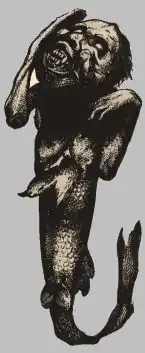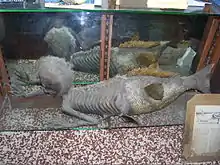Fiji mermaid
The Fiji mermaid (also Feejee mermaid) was an object composed of the torso and head of a juvenile monkey sewn to the back half of a fish. It was a common feature of sideshows where it was presented as the mummified body of a creature that was supposedly half mammal and half fish, a version of a mermaid. The original had fish scales with animal hair superimposed on its body with pendulous breasts on its chest. The mouth was wide open with its teeth bared. The right hand was against the right cheek, and the left tucked under its lower left jaw.[2] This mermaid was supposedly caught near the Fiji Islands in the South Pacific.[3] Several replicas and variations have also been made and exhibited under similar names and pretexts.[4] P. T. Barnum exhibited the original in Barnum's American Museum in New York in 1842, but it then disappeared—likely destroyed in one of Barnum's many fires that destroyed his collections.[5]


History
Barnum, in his autobiography, described the mermaid as "an ugly dried-up, black-looking diminutive specimen, about 3 feet long. Its mouth was open, its tail turned over, and its arms thrown up, giving it the appearance of having died in great agony."[6] As such, its depiction differed greatly from the traditional descriptions of mermaids as attractive creatures.[6]
American sea captain Samuel Barrett Edes bought Barnum's "mermaid" from Japanese sailors in 1822 for $6,000,[7][8] using money from the ship's expense account.[9] The mermaid is believed to have been created by Japanese fishermen as a joke,[10] or as a religious icon for ceremonial purposes.[11]
It was displayed in London in 1822 and was advertised in a publication by J. Limbird in the Mirror.[7] Captain Edes' son took possession of the mermaid and sold it to Moses Kimball of the Boston Museum in 1842, and he brought it to New York City that summer to show it to P. T. Barnum.[7] Barnum had a naturalist examine it who would not attest to its authenticity.[7][12] Nevertheless, Barnum believed that the relic would draw the public to the museum. Kimball remained the creature's sole owner, while Barnum leased it for $12.50 a week.[13][14] Barnum generated publicity for the object by having an agent send anonymous letters to New York newspapers from Montgomery, Alabama and Charleston, South Carolina, contending that "Dr. J. Griffin" had an object which he had caught in South America. Griffin was actually being impersonated by Levi Lyman, one of Barnum's associates.[12][15][16] To keep the plan working, Griffin checked in to a Philadelphia hotel, then showed the mermaid to the landlord as a thanks for his hospitality. The landlord was so intrigued that he begged Griffin to show it to some of his friends, many of whom were editors.[12][17]
Griffin traveled to New York and displayed it to a small audience, then displayed it as the Fiji Mermaid in the concert hall for a week.[16] It was actually only displayed for five days because Barnum had "convinced" Griffin to bring it to the American Museum of Natural History. Barnum printed 10,000 pamphlets which described mermaids in general and his specimen in particular.[18]
Later incarnations

In his Secrets of the Sideshows, Joe Nickell documents several modern-day claimants to the title of Barnum's "true" original mermaid, or as he describes them, "fakes of Barnum's fake". Exhibits at Ripley's Believe It Or Not, Coney Island's Sideshow by the Seashore, and Bobby Reynolds' traveling sideshow all lay claim to the title, but in Nickell's opinion, none is to be believed.[19] He also describes an update of the tradition that uses an elaborate system to project the image of a live woman into a fishbowl, giving the appearance that she is only an inch or two long. He relates the story of a performer who was smoking a cigarette in her hidden chamber; the man outside was confronted by an angry patron who demanded to know how this was possible if the "mermaid" was underwater.[20]

A guide to constructing a Fiji mermaid appeared in the November 2009 issue of Fortean Times magazine, in an article written by special effects expert and stop-motion animator Alan Friswell. Rather than building the figure with fish and monkey parts, Friswell used papier mache and modelling putty, sealed with wallpaper paste, and with doll's hair glued to the scalp.
In popular culture
- In Rob Zombie's House of 1000 Corpses, Rainn Wilson's character is murdered and his corpse is transformed into a Fiji mermaid via taxidermy.
- The Fiji Mermaid is referenced in the track "Megalodon" from Mastodon's second album, Leviathan, and is also depicted in the album artwork.
- In the 90s TV series The X-Files, the episode "Humbug" depicts the possibility of a series of sideshow murders having been committed by a Fiji mermaid.
- In the 2010 animated series Scooby-Doo! Mystery Incorporated, the Fiji Mermaid makes an appearance as one of the objects in display at Darrow's Oddity Museum, in the episode "The Secret Serum".
- In the 2012 animated series Gravity Falls, the Fiji Mermaid makes an appearance as one of the objects in display at the Mystery Shack, appearing first in the episode "Tourist Trapped".
- In 2012, the indie rock band mewithoutYou recorded the song "Fiji Mermaid" on their fifth album, Ten Stories.[21]
- They make an appearance in Mermaids: The New Evidence, a sequel to Mermaids: The Body Found.
- In the 2019 film Missing Link, the fiji mermaid is depicted towards the end of the film
| Part of a series on the |
| Paranormal |
|---|
References
- "Feejee Mermaid". Peabody Museum. 2019.
- Levi, Steven C (April 1977). "P. T. Barnum and the Feejee Mermaid". Western Folklore. 36 (2): 151. doi:10.2307/1498966.
- Boese, Alex (2014). "The Feejee Mermaid."
- Nickell, Joe (2005). Secrets of the Sideshows. Lexington: University Press of Kentucky. pp. 333–335.
- Levi, Steven C (April 1977). "P. T. Barnum and the Feejee Mermaid". Western Folklore 36 (2): 149.
- September 2016, Jessie Szalay 09. "The Feejee Mermaid: Early Barnum Hoax". livescience.com. Retrieved 2020-09-02.
- Barnum, P.T. (1871). Struggles and Triumphs: or, Forty Years' Recollections of P.T. Barnum. New York: American News Company. pp. 129–130.
- Levi, Steven C (April 1977). "P. T. Barnum and the Feejee Mermaid". Western Folklore. 36 (2): 149–151. doi:10.2307/1498966.
- Levi, Steven C (April 1977). "P.T. Barnum and the Feejee Mermaid". Western Folklore 36 (2): 150.
- Levi, Steven C. (1977). "P. T. Barnum and the Feejee Mermaid". Western Folklore. 36 (2): 149–154. doi:10.2307/1498966. ISSN 0043-373X.
- "The Feejee Mermaid". Museum of Hoaxes. Retrieved 2020-09-02.
- "The Feejee Mermaid Archive". The Lost Museum. American Social History Project/Center for Media Learning. Retrieved 30 March 2014.
- Bondeson (1999), p. 50.
- Zipp, Yvonne (August 2011). "P.T. Barnum’s Women." p. 2
- Reiss, Benjamin (2009-06-30). The Showman and the Slave. Cambridge, MA: Harvard University Press. pp. 181–182. ISBN 0-674-04265-4.
- Levi, Steven C (April 1977). "P. T. Barnum and the Feejee Mermaid". Western Folklore. 36 (2): 150. doi:10.2307/1498966.
- Barnum, P.T. (1871). Struggles and Triumphs: or, Forty Years' Recollections of P.T. Barnum. New York: American News Company. p. 129
- Levi, Steven C (April 1977). "P.T. Barnum and the Fiji Mermaid". Western Folklore. 36 (2): 150–151. doi:10.2307/1498966.
- Nickell, pp. 334–335.
- Nickell, pp. 292–293.
- "Archived copy". Archived from the original on 2016-11-04. Retrieved 2016-11-03.CS1 maint: archived copy as title (link)
- Bibliography
- Bondeson, Jan (1999). The Feejee mermaid. The Feejee mermaid and other essays in natural and unnatural history. Ithaca, NY: Cornell University Press. pp. 36–63. ISBN 0-801-43609-5.
- James W. Cook. (2001). The arts of deception : playing with fraud in the age of Barnum. Cambridge, Massachusetts: Harvard University Press. ISBN 0-674-00457-4.
- Joe Nickell (2005). Secrets of the Sideshows. Lexington, KY: University Press of Kentucky. ISBN 978-0-8131-2358-5.
- A. H. Saxon (1995). P.T. Barnum : legend and the man. New York: Columbia University Press. ISBN 978-0-231-05687-8.